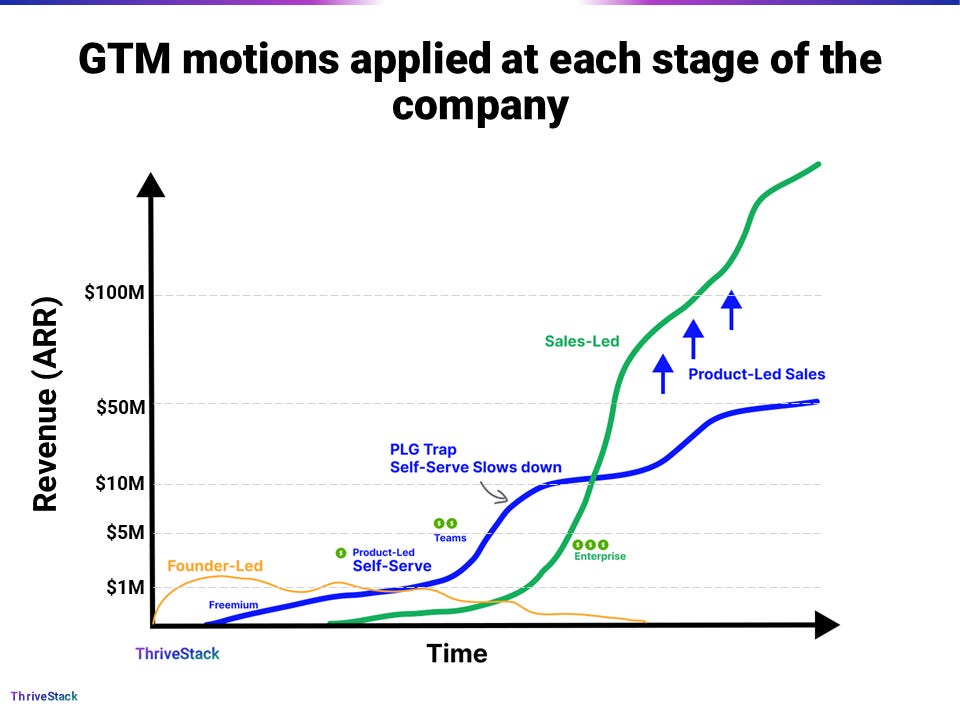Successful SaaS companies use a multi-pronged approach to GTM
Moving beyond the PLG vs SLG debate, here's a revenue factory playbook to go from $0 → $100M+
tl;dr:
Multi-pronged GTM strategy combined with the Lean Revenue Factory model is key to scaling SaaS companies from $0 to $100M+ ARR.
Segment GTM efforts by market tiers: SMB, Mid-Market, and Enterprise.
Key strategies include:
Founder-led: Direct engagement with customers for rapid feedback.
Self-serve: Freemium models and free trials for quick user acquisition.
Product-led Sales: Upsell and cross-sell opportunities based on user data.
Enterprise Sales-led: Consultative selling for large organizations.
Tailored strategies and metrics for each segment optimize revenue generation and drive sustainable growth.
Multi-Pronged GTM Strategy
Successful SaaS companies leverage a combination of the following approaches to establish a robust GTM strategy:
1. Founder-led Revenue
In the initial stages, founders drive growth through direct engagement with customers. This hands-on approach allows for rapid feedback and iteration, helping to refine the product and establish a strong market presence.
2. Self-serve Revenue
As the product matures, a self-serve model enables users to onboard independently, often through freemium offerings or free trials. This method is particularly effective for products that can demonstrate value quickly, allowing for rapid user acquisition without significant sales overhead.
Read some of the fundamentals here: Fundamentals of self-service SaaS
3. Product-led Sales Revenue
With a product-led sales approach, the focus shifts to leveraging existing user data to identify upsell and cross-sell opportunities. This strategy enhances customer retention and maximizes the lifetime value of existing accounts.
Learn more from the McKinsey Report: From product-led growth to product-led sales: Beyond the PLG hype
4. Enterprise Sales-led Revenue
For larger organizations, an enterprise sales-led strategy becomes crucial. This involves a dedicated sales team that engages with decision-makers in enterprise accounts, addressing their specific needs and providing tailored solutions.
Lean Revenue Factory Model
The Lean Revenue Factory model treats revenue generation as a manufacturing process, where each GTM motion is viewed as a separate production line. This approach emphasizes efficiency, sustainability, and continuous improvement, inspired by lean manufacturing principles.
Segmenting Production Lines
To optimize revenue generation, it is essential to separate the production lines for different market segments: SMB, Mid-Market, and Enterprise. Each segment has unique characteristics and requires specific strategies.
1. SMB Segment
For the SMB segment, the focus is on self-serve and product-led sales. The goal is to minimize CAC while maximizing conversion rates. Companies should implement automated onboarding processes and leverage customer feedback to refine the product continuously. Key metrics include CAC, conversion rates, and churn rates.
2. Mid-Market Segment
The mid-market segment benefits from a hybrid approach, combining self-serve elements with enterprise sales strategies. This allows for greater flexibility and responsiveness to customer needs. Companies should focus on nurturing leads through targeted marketing campaigns and personalized outreach. Key metrics to monitor include Monthly Recurring Revenue (MRR), upsell rates, and customer lifetime value (CLV).
3. Enterprise Segment
A dedicated sales team is essential in the enterprise segment to manoeuvre the complex sales processes and engage multiple stakeholders. This approach requires a consultative selling strategy that addresses the unique needs of each enterprise client. Key metrics for this segment include gross revenue retention, sales cycle length, and average deal size.
For further insights into GTM efficiency and its impact on revenue production, refer to the original article by
here.While you're busy cracking the other stuff, how about letting us handle the self-serve part?
>97% of Buyers prefer to Discover Value by Signing up and Trying SaaS products.
We enable SaaS Companies to Build, Distribute, and Operate SaaS Products in this new Age of Self-Service.








